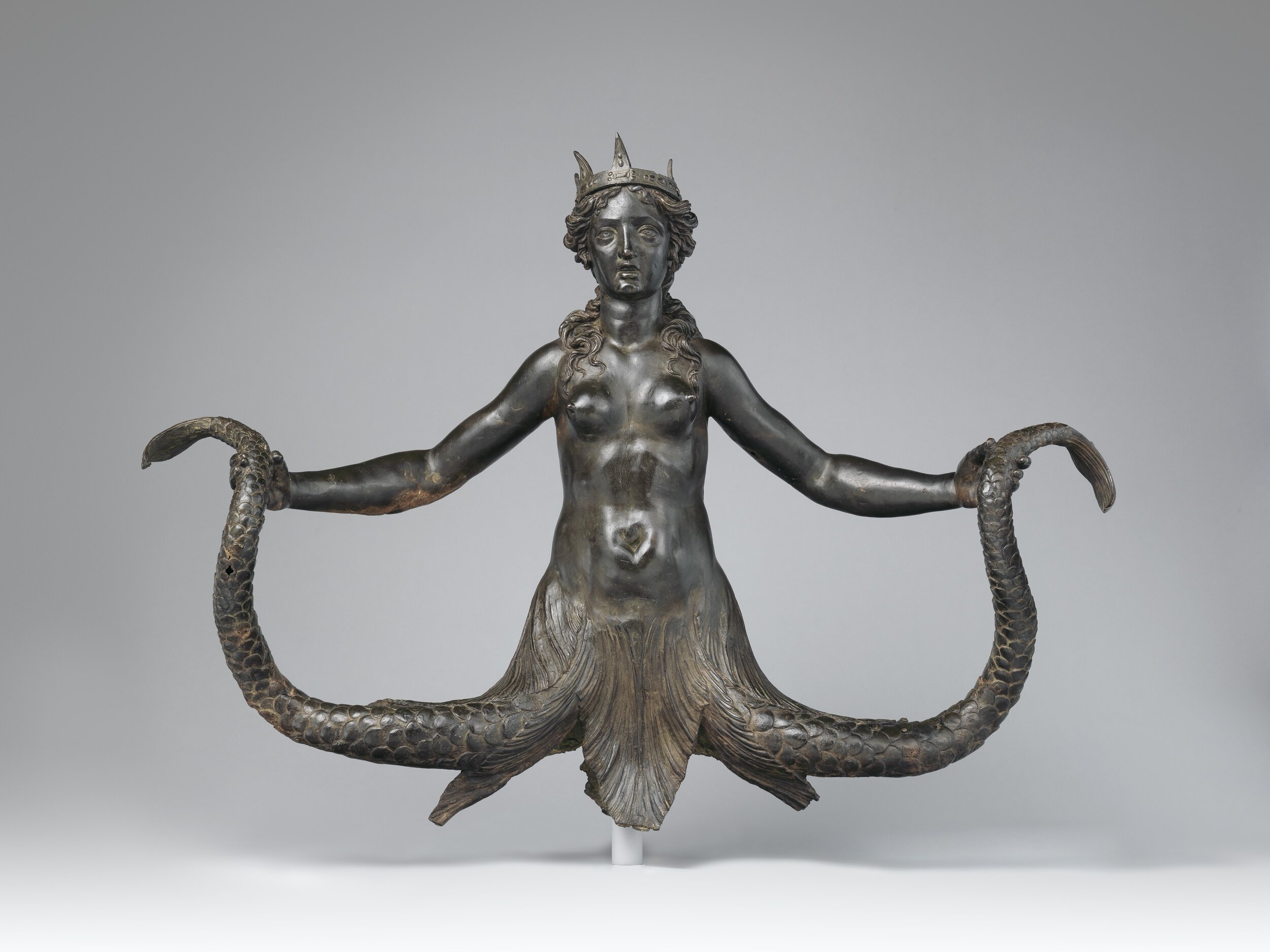La Sirena Amulet
Sirens in Greek Mythology
From Greek mythology, sirens emerge as mesmerizing yet treacherous beings, their haunting melodies weaving spells of irresistible allure. Once depicted with the head of a woman and the body of a bird, these mystical creatures possessed voices so enchanting that sailors, entranced by their song, would lose themselves in pursuit—often to disastrous ends. Legends tell of their presence along perilous shores, where the hypnotic strains of their music lured ships to ruin. Among the most famed encounters, Homer’s Odyssey recounts how the clever Odysseus, yearning for knowledge yet wary of their power, devised a cunning plan to hear their song without succumbing to its peril.
Terracotta statuette of a siren c. 550–500 B.C. Greek, The Metropolitan Museum of Art. Sirens are mythical creatures famous in antiquity for their song, which lured sailors to their death. Sanctuaries to the sirens are known to have existed in parts of South Italy and Sicily, as the geographer Strabo and other ancient writers tell us. This large, hand-modeled sculpture with applied decoration may well have been a votive offering at such a sanctuary.
Transformation into Mermaids
As centuries passed, the image of the siren underwent a captivating transformation. Once depicted as bird-like enchantresses, they gradually took on the form of the sea itself—graceful beings with the upper body of a woman and the shimmering tail of a fish. This shift, believed to have occurred during the Hellenistic period, saw sirens merging with the Nereids, the gentle sea nymphs of ancient lore. These divine maidens, often portrayed riding dolphins across the waves, embodied the ocean’s beauty and boundless mystery.
With time, sirens and mermaids became one, their legend rippling across cultures from the Near East to Europe, Africa, and Asia. As emissaries of the deep, mermaids came to symbolize the ocean’s dual nature—both enchanting and perilous. Some tales spoke of their kindness, foretelling the future, bestowing gifts, or healing the weary. Others warned of their power to summon storms or lead sailors astray, reminding all who dared to venture into the unknown that the sea is as unpredictable as it is alluring.
Siren c. 1571-90. The Metropolitan Museum of Art. Direct and dramatic, this bronze half-length statue represents a nude woman, aquatic from the waist down, who holds a scaly tail in each hand. Her long hair trails behind her to a set of fish gills that fan out from all sides of her body. She wears a pointed crown, which is clearly a later addition. The statue reflects traditional types of mermaid figures and in particular the mythic Greek sirens. The sculptured figure of a woman holding her own fish tails can be found on Romanesque capitals, and in the sixteenth century the image became a decorative motif for tapestries and small bronze candelabra.
Siren Amulets
The fish-lady concept of the mermaid takes us to the topic at hand: old silver amulets called Sirene (mermaids) or Cavalli Marini (sea horses). In The Evil Eye, Elworthy explains that these amulets were suspended from chains and “Like all Diana charms, they are of silver.” They were either worn by Neapolitan ladies “outside the dress” or hung up in the house. Unlike the cimaruta, they were usually double-sided. Here is an example of a “Siren” amulet from the collection of The Victoria & Albert Museum in London:
“Amulets in the form of a mermaid, or sirena in Spanish, had been used in Spain since the 17th century. This particular form, with the mermaid blowing a trumpet, was mainly used by women and children as a protection against the evil eye. The noise of the bells hanging along the lower edge would similarly help to frighten off any evil spirits. It was bought for the museum by Senor Riano for three shillings and four pence in Cordoba in 1871.”
Sirens/Mermaids are still popular symbols in modern times — the Starbucks logo was (allegedly) modeled on a siren from a 16th century Nordic woodcut and has maintained its mermaid roots while evolving into its modern, less risque and more corporate iteration.
Cultural Significance
The transformation from siren to mermaid reflects a broader cultural shift in how the sea was perceived. While the ancient Greeks viewed the ocean as a realm of danger, later interpretations embraced it as a source of wonder and exploration. Mermaids, therefore, came to represent the allure and mystery of the sea, embodying both its beauty and its potential for peril.
The enduring legacy of sirens and mermaids continues to captivate our imagination, symbolizing the human fascination with the unknown and the powerful forces of nature. Whether as ominous figures of ancient myths or enchanting beings of modern fairy tales, these creatures serve as a reminder of the profound connection between humanity and the sea.
More Mermaid Lore to Explore:
Ceramic (Neckless) Mermaid, House of Good Fortune Collection
Mexican Folk Art Merman Ornament, House of Good Fortune Collection, Courtesy of Eye’s Gallery
Mermaid Bottle Opener, Made in Italy, House of Good Fortune Collection
Mermaid Bottle Opener with expressions of good cheer, “A Toast to the Host,” House of Good Fortune Collection








